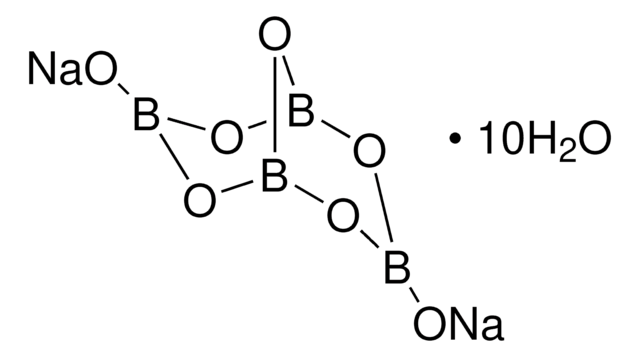About This Item
Recommended Products
vapor pressure
2.6 mmHg ( 20 °C)
Quality Level
product line
BioXtra
Assay
≥99.5%
form
powder
impurities
≤0.005% Phosphorus (P)
≤0.1% Insoluble matter
pH
3.5-6.0 (0.5 M in H2O)
mp
160 °C (dec.) (lit.)
solubility
H2O: 0.5 M, clear, colorless
anion traces
chloride (Cl-): ≤0.05%
sulfate (SO42-): ≤0.05%
cation traces
Al: ≤0.0005%
Ca: ≤0.005%
Cu: ≤0.0005%
Fe: ≤0.0005%
K: ≤0.005%
Mg: ≤0.005%
NH4+: ≤0.05%
Na: ≤0.01%
Pb: ≤0.001%
Zn: ≤0.0005%
absorption
≤0.05 at 260 in H2O at 1 M
≤0.05 at 280 in H2O at 1 M
UV absorption
λ: 260 nm Amax: 0.05
λ: 280 nm Amax: 0.05
SMILES string
OB(O)O
InChI
1S/BH3O3/c2-1(3)4/h2-4H
InChI key
KGBXLFKZBHKPEV-UHFFFAOYSA-N
Looking for similar products? Visit Product Comparison Guide
Application
- Effect of Boron Content in LiOH Solutions on the Corrosion Behavior of Zr-Sn-Nb Alloy.: This study investigates how varying boron content in lithium hydroxide solutions affects the corrosion resistance of Zr-Sn-Nb alloys, commonly used in nuclear reactors. The findings highlight the potential for boric acid to enhance the longevity and safety of these materials (Zhao et al., 2024).
- GpEF1A: A Novel Lysine Methyltransferase Gene from Gypsophila perfoliata L. Involved in Boron Homeostasis.: This study identifies a new gene involved in boron regulation in plants, providing insights into boric acid′s role in maintaining cellular homeostasis and potential applications in agricultural biotechnology (Akbudak et al., 2024).
Signal Word
Danger
Hazard Statements
Precautionary Statements
Hazard Classifications
Repr. 1B
Storage Class Code
6.1D - Non-combustible acute toxic Cat.3 / toxic hazardous materials or hazardous materials causing chronic effects
WGK
WGK 1
Flash Point(F)
Not applicable
Flash Point(C)
Not applicable
Personal Protective Equipment
Choose from one of the most recent versions:
Already Own This Product?
Find documentation for the products that you have recently purchased in the Document Library.
Customers Also Viewed
Our team of scientists has experience in all areas of research including Life Science, Material Science, Chemical Synthesis, Chromatography, Analytical and many others.
Contact Technical Service






